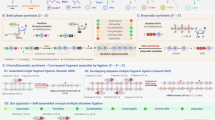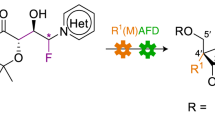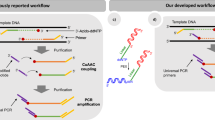Abstract
We describe procedures for the synthesis of a fluorescent pyrimidine analog and its site-specific incorporation into a DNA oligomer. The 5′-protected and 3′-activated nucleoside 4 is synthesized in three steps with an overall yield of 40%. Site-specific incorporation into a DNA oligomer occurs with greater than 88% coupling efficiency. This isosteric fluorescent DNA analog can be used to monitor denaturation of DNA duplexes via fluorescence and can positively detect the presence of abasic sites in DNA duplexes. The total time for synthesis of the phosphoramidite 4 is about 75 h, whereas the total time for site-specific incorporation of nucleoside 2 into an oligonucleotide and purification of the corresponding oligonucleotide is about 114 hours.
This is a preview of subscription content, access via your institution
Access options
Subscribe to this journal
Receive 12 print issues and online access
$259.00 per year
only $21.58 per issue
Buy this article
- Purchase on SpringerLink
- Instant access to full article PDF
Prices may be subject to local taxes which are calculated during checkout





Similar content being viewed by others
References
Daniels, M. & Hauswirth, W. Fluorescence of the purine and pyrimidine bases of the nucleic acids in neutral aqueous solution at 300 degrees K. Science 171, 675–677 (1971).
Pecourt, J.M.L., Peon, J. & Kohler, B. Ultrafast internal conversion of electronically excited RNA and DNA nucleosides in water. J. Am. Chem. Soc. 122, 9348–9349 (2000).
Nir, E., Kleinermanns, K., Grace, L. & de Vries, M.S. On the photochemistry of purine nucleobases. J. Phys. Chem. A 105, 5106–5110 (2001).
Coleman, R.S. & Madaras, M.L. Synthesis of a novel coumarin C-riboside as a photophysical probe of oligonucleotide dynamics. J. Org. Chem. 63, 5700–5703 (1998).
Nakatani, K., Dohno, C. & Saito, I. Chemistry of sequence-dependent remote guanine oxidation: Photoreaction of duplex DNA containing cyanobenzophenone-substituted uridine. J. Am. Chem. Soc. 121, 10854–10855 (1999).
Strässler, C., Davis, N.E. & Kool, E.T. Novel nucleoside analogues with fluorophores replacing the DNA base. Helv. Chim. Acta 82, 2160–2171 (1999).
Wojczewski, C., Stolze, K. & Engels, J.W. Fluorescent oligonucleotides - Versatile tools as probes and primers for DNA and RNA analysis. Synlett. 1667–1678 (1999).
Seela, F., Zulauf, M., Sauer, M. & Deimel, M. 7-substituted 7-deaza-2′-deoxyadenosines and 8-aza-7-deaza-2′-deoxyadenosines: Fluorescence of DNA-base analogues induced by the 7-alkynyl side chain. Helv. Chim. Acta 83, 910–927 (2000).
Hawkins, M.E. Fluorescent pteridine nucleoside analogs: a window on DNA interactions. Cell Biochem. Biophys. 34, 257–281 (2001).
Murphy, C.J. Photophysical probes of DNA sequence-directed structure and dynamics. Adv. Photochem. 26, 145–217 (2001).
Hurley, D.J., Seaman, S.E., Mazura, J.C. & Tor, Y. Fluorescent 1,10-phenanthroline-containing oligonucleotides distinguish between perfect and mismatched base pairing. Org. Lett. 4, 2305–2308 (2002).
Rist, M.J. & Marino, J.P. Fluorescent nucleotide base analogs as probes of nucleic acid structure, dynamics and interactions. Curr. Org. Chem. 6, 775–793 (2002).
Coleman, R.S. & Mortensen, M.A. Stereocontrolled synthesis of anthracene beta-C-ribosides: fluorescent probes for photophysical studies of DNA. Tetrahedron Lett. 44, 1215–1219 (2003).
Dash, C., Rausch, J.W. & Le Grice, S.F. Using pyrrolo-deoxycytosine to probe RNA/DNA hybrids containing the human immunodeficiency virus type-1 3′ polypurine tract. Nucleic Acids Res. 32, 1539–1547 (2004).
Jiao, G.S., Kim, T.G., Topp, M.R. & Burgess, K. A blue-to-red energy-transfer thymidine analogue that functions in DNA. Org. Lett. 6, 1701–1704 (2004).
Mayer, E. et al. 1-Ethynylpyrene as a tunable and versatile molecular beacon for DNA. ChemBioChem 5, 865–868 (2004).
Okamoto, A., Kanatani, K. & Saito, I. Pyrene-labeled base-discriminating fluorescent DNA probes for homogeneous SNP typing. J. Am. Chem. Soc. 126, 4820–4827 (2004).
Gaballah, S.T., Vaught, J.D., Eaton, B.E. & Netzel, T.L. Charge-transfer excited state dynamics in DNA hairpins substituted with an ethylenylpyrenyl-dU electron source and halo-dU traps. J. Phys. Chem. B 109, 5927–5934 (2005).
Okamoto, A., Saito, Y. & Saito, I. Design of base-discriminating fluorescent nucleosides. J. Photochem. Photobiol., C 6, 108–122 (2005).
Okamoto, A., Tainaka, K., Nishiza, K. & Saito, I. Monitoring DNA structures by dual fluorescence of pyrene derivatives. J. Am. Chem. Soc. 127, 13128–13129 (2005).
Okamoto, A., Tainaka, K. & Saito, I. A dielectric-sensitive fluorescent DNA probe for monitoring polarities on the interior of a DNA-binding protein. Bioconjugate Chem. 16, 1105–1111 (2005).
Ranasinghe, R.T. & Brown, T. Fluorescence based strategies for genetic analysis. Chem. Commun. 5487–5502 (2005).
Sandin, P. et al. Fluorescent properties of DNA base analogue tC upon incorporation into DNA--negligible influence of neighbouring bases on fluorescence quantum yield. Nucleic Acids Res. 33, 5019–5025 (2005).
Andreatta, D. et al. Ultrafast dynamics in DNA: “fraying” at the end of the helix. J. Am. Chem. Soc. 128, 6885–6892 (2006).
Asseline, U. Development and applications of fluorescent oligonucleotides. Curr. Org. Chem. 10, 491–518 (2006).
Cho, Y. & Kool, E.T. Enzymatic synthesis of fluorescent oligomers assembled on a DNA backbone. ChemBioChem 7, 669–672 (2006).
Kim, S.J. & Kool, E.T. Sensing metal ions with DNA building blocks: fluorescent pyridobenzimidazole nucleosides. J. Am. Chem. Soc. 128, 6164–6171 (2006).
Silverman, A.P. & Kool, E.T. Detecting RNA and DNA with templated chemical reactions. Chem. Rev. 106, 3775–3789 (2006).
Ward, D.C., Reich, E. & Stryer, L. Fluorescence studies of nucleotides and polynucleotides. I. Formycin, 2-aminopurine riboside, 2,6-diaminopurine riboside, and their derivatives. J. Biol. Chem. 244, 1228–1237 (1969).
Seela, F. & Becher, G. Synthesis, base pairing, and fluorescence properties of oligonucleotides containing 1H-pyrazolo[3,4-d]pyrimidin-6-amine (8-aza-7-deazapurin-2-amine) as an analogue of purin-2-amine. Helv. Chim. Acta 83, 928–942 (2000).
Jean, J.M. & Hall, K.B. 2-Aminopurine fluorescence quenching and lifetimes: role of base stacking. Proc. Natl. Acad. Sci. USA 98, 37–41 (2001).
Kawai, M., Lee, M.J., Evans, K.O. & Nordlund, T.M. Temperature and base sequence dependence of 2-aminopurine fluorescence bands in single- and double-stranded oligodeoxynucleotides. J. Fluoresc. 11, 23–32 (2001).
Rachofsky, E.L., Osman, R. & Ross, J.B. Probing structure and dynamics of DNA with 2-aminopurine: effects of local environment on fluorescence. Biochemistry 40, 946–956 (2001).
Menger, M., Tuschl, T., Eckstein, F. & Porschke, D. Mg(2+)-dependent conformational changes in the hammerhead ribozyme. Biochemistry 35, 14710–14716 (1996).
Kirk, S.R., Luedtke, N.W. & Tor, Y. 2-Aminopurine as a real-time probe of enzymatic cleavage and inhibition of hammerhead ribozymes. Bioorg. Med. Chem. 9, 2295–2301 (2001).
Rist, M. & Marino, J. Association of an RNA kissing complex analyzed using 2-aminopurine fluorescence. Nucleic Acids Res. 29, 2401–2408 (2001).
Lacourciere, K.A., Stivers, J.T. & Marino, J.P. Mechanism of neomycin and Rev peptide binding to the Rev responsive element of HIV-1 as determined by fluorescence and NMR spectroscopy. Biochemistry 39, 5630–5641 (2000).
DeJong, E.S., Chang, C.E., Gilson, M.K. & Marino, J.P. Proflavine acts as a Rev inhibitor by targeting the high-affinity Rev binding site of the Rev responsive element of HIV-1. Biochemistry 42, 8035–8046 (2003).
Kaul, M., Barbieri, C.M. & Pilch, D.S. Fluorescence-based approach for detecting and characterizing antibiotic-induced conformational changes in ribosomal RNA: comparing aminoglycoside binding to prokaryotic and eukaryotic ribosomal RNA sequences. J. Am. Chem. Soc. 126, 3447–3453 (2004).
Shandrick, S. et al. Monitoring molecular recognition of the ribosomal decoding site. Angew. Chem., Int. Ed. Engl. 43, 3177–3182 (2004).
Constant, J.F. et al. Design of molecules which specifically cleave abasic sites in DNA. Anti-Cancer Drug Des. 5, 59–62 (1990).
Weinfeld, M., Liuzzi, M. & Paterson, M.C. Response of phage T4 polynucleotide kinase toward dinucleotides containing apurinic sites: design of a 32P-postlabeling assay for apurinic sites in DNA. Biochemistry 29, 1737–1743 (1990).
Chen, B.X. et al. Properties of a monoclonal antibody for the detection of abasic sites, a common DNA lesion. Mutat. Res. 273, 253–261 (1992).
Kubo, K., Ide, H., Wallace, S.S. & Kow, Y.W. A novel, sensitive, and specific assay for abasic sites, the most commonly produced DNA lesion. Biochemistry 31, 3703–3708 (1992).
Fkyerat, A. et al. A new class of artificial nucleases that recognize and cleave apurinic sites in DNA with great selectivity and efficiency. J. Am. Chem. Soc. 115, 9952–9959 (1993).
Ide, H. et al. Synthesis and damage specificity of a novel probe for the detection of abasic sites in DNA. Biochemistry 32, 8276–8283 (1993).
Berthet, N. et al. Design of molecules that specifically recognize and cleave apurinic sites in DNA. J. Mol. Recognit. 7, 99–107 (1994).
Belmont, P. et al. Efficient and versatile chemical tools for cleavage of abasic sites in DNA. New J. Chem. 21, 47–54 (1997).
Berthet, N. et al. Search for DNA repair inhibitors: selective binding of nucleic bases-acridine conjugates to a DNA duplex containing an abasic site. J. Med. Chem. 40, 3346–3352 (1997).
Boturyn, D. et al. Synthesis of fluorescent probes for the detection of abasic sites in DNA. Tetrahedron 53, 5485–5492 (1997).
Boturyn, D. et al. Quantitative one step derivatization of oligonucleotides by a fluorescent label through abasic site formation. Nucleosides Nucleotides 16, 2069–2077 (1997).
Adamczyk, M., Mattingly, P.G. & Moore, J.A. O-(fluoresceinylmethyl)hydroxylamine (OFMHA): a fluorescent reagent for detection of damaged nucleic acids. Bioorg. Med. Chem. Lett. 8, 3599–3602 (1998).
Asaeda, A. et al. Highly sensitive assay of DNA abasic sites in mammalian cells optimization of the aldehyde reactive probe method. Anal. Chim. Acta 365, 35–41 (1998).
Makrigiorgos, G.M., Chakrabarti, S. & Mahmood, A. Fluorescent labelling of abasic sites: a novel methodology to detect closely-spaced damage sites in DNA. Int. J. Radiat. Biol. 74, 99–109 (1998).
Berthet, N. et al. Recognition of abasic sites in DNA by a cyclobisacridine molecule. Chem. Eur. J. 5, 3625–3630 (1999).
Boturyn, D. et al. A simple and sensitive method for in vitro quantitation of abasic sites in DNA. Chem. Res. Toxicol. 12, 476–482 (1999).
Lhomme, J., Constant, J.F. & Demeunynck, M. Abasic DNA structure, reactivity, and recognition. Biopolymers 52, 65–83 (1999).
Teulade-Fichou, M.P. et al. Specific recognition and stabilization of an abasic site-containing DNA duplex by a macrocyclic bisacridine. Nucleosides Nucleotides 18, 1351–1353 (1999).
Atamna, H., Cheung, I. & Ames, B.N. A method for detecting abasic sites in living cells: age-dependent changes in base excision repair. Proc. Natl. Acad. Sci. USA 97, 686–691 (2000).
Bowman, K.J. et al. Evaluation of phosphodiesterase I-based protocols for the detection of multiply damaged sites in DNA: the detection of abasic, oxidative and alkylative tandem damage in DNA oligonucleotides. Nucleic Acids Res. 29, E101 (2001).
Sun, H.B., Qian, L. & Yokota, H. Detection of abasic sites on individual DNA molecules using atomic force microscopy. Anal. Chem. 73, 2229–2232 (2001).
Zhang, L.K., Rempel, D. & Gross, M.L. Matrix-assisted laser desorption/ionization mass spectrometry for locating abasic sites and determining the rates of enzymatic hydrolysis of model oligodeoxynucleotides. Anal. Chem. 73, 3263–3273 (2001).
Georgakilas, A.G., Bennett, P.V. & Sutherland, B.M. High efficiency detection of bi-stranded abasic clusters in gamma-irradiated DNA by putrescine. Nucleic Acids Res. 30, 2800–2808 (2002).
Hirose, T., Ohtani, T., Muramatsu, H. & Tanaka, A. Direct visualization of abasic sites on a single DNA molecule using fluorescence microscopy. Photochem. Photobiol. 76, 123–126 (2002).
Zhang, L.K. & Gross, M.L. Location of abasic sites in oligodeoxynucleotides by tandem mass spectrometry and by a chemical cleavage initiated by an unusual reaction of the ODN with MALDI matrix. J. Am. Soc. Mass. Spectrom. 13, 1418–1426 (2002).
Ide, H. et al. Detection of DNA damage by the aldehyde reactive probe (ARP) assay: principles and its application. Recent Res. Devel. Nucleosides Nucleotides 1, 33–47 (2003).
Kim, J., Muramatsu, H., Lee, H. & Kawai, T. Near-field optical imaging of abasic sites on a single DNA molecule. FEBS Lett. 555, 611–615 (2003).
Yanagisawa, H., Hirano, A. & Sugawara, M. A dot-blot method for quantification of apurinic/apyrimidinic sites in DNA using an avidin plate and liposomes encapsulating a fluorescence dye. Anal. biochem. 332, 358–367 (2004).
Chakravarti, D. et al. Improved measurement of dibenzo[a,l]pyrene-induced abasic sites by the aldehyde-reactive probe assay. Mutat. Res. 588, 158–165 (2005).
Sato, K. & Greenberg, M.M. Selective detection of 2-deoxyribonolactone in DNA. J. Am. Chem. Soc. 127, 2806–2807 (2005).
Zhou, X. et al. Quantification of DNA strand breaks and abasic sites by oxime derivatization and accelerator mass spectrometry: application to gamma-radiation and peroxynitrite. Anal. biochem. 343, 84–92 (2005).
Dolinnaya, N.G. et al. Electrochemical detection of abasic site-containing DNA. Electroanalysis 18, 399–404 (2006).
Huang, W. et al. Electrochemical detection at low temperature for a specific nucleobase of target nucleic acids by an abasic site-containing DNA binding ligand. Electrochem. Commun. 8, 395–398 (2006).
Martelli, A. et al. Photoreactive threading agent that specifically binds to abasic sites in DNA. Bioorg. Med. Chem. Lett. 16, 154–157 (2006).
Morita, K. et al. Electrochemical SNPs detection using an abasic site-containing DNA on a gold electrode. Chem. Commun. 2376–2378 (2006).
Roberts, K.P. et al. Determination of apurinic/apyrimidinic lesions in DNA with high-performance liquid chromatography and tandem mass spectrometry. Chem. Res. Toxicol. 19, 300–309 (2006).
Fukui, K. et al. Synthesis and properties of an oligonucleotide modified with an acridine derivative at the artificial abasic site. Bioconjugate Chem. 7, 349–355 (1996).
Fukui, K. & Tanaka, K. The acridine ring selectively intercalated into a DNA helix at various types of abasic sites: double strand formation and photophysical properties. Nucleic Acids Res. 24, 3962–3967 (1996).
Fukui, K.I., Kazunori, Shimidzu, T. & Tanaka, K. Oligonucleotides covalently linked to an acridine at artificial abasic site: influence of linker length and the base-sequence. Tetrahedron Lett. 37, 4983–4986 (1996).
Belmont, P., Alarcon, K., Demeunynck, M. & Lhomme, J. Synthesis of an imidazo[1,2-e]purine-acridine heterodimer for targeting abasic sites in DNA. Bioorg. Med. Chem. Lett. 9, 233–236 (1999).
Matray, T.J. & Kool, E.T. A specific partner for abasic damage in DNA. Nature 399, 704–708 (1999).
Alarcon, K. et al. Diaminopurine-acridine heterodimers for specific recognition of abasic site containing DNA. Influence on the biological activity of the position of the linker on the purine ring. Bioorg. Med. Chem. Lett. 11, 1855–1858 (2001).
Alarcon, K. et al. Potentiation of BCNU cytotoxicity by molecules targeting abasic lesions in DNA. Bioorg. Med. Chem. 9, 1901–1910 (2001).
Brotschi, C., Häberli, A. & Leumann, C.J. A stable DNA duplex containing a non-hydrogen-bonding and non-shape-complementary base couple: interstrand stacking as the stability determining factor. Angew. Chem. Int. Ed. Engl. 40, 3012–3014 (2001).
Yoshimoto, K., Nishizawa, S., Minagawa, M. & Teramae, N. Use of abasic site-containing DNA strands for nucleobase recognition in water. J. Am. Chem. Soc. 125, 8982–8983 (2003).
Langenegger, S.M. & Haener, R. A simple, non-nucleosidic base surrogate increases the duplex stability of DNA containing an abasic site. Chem. Biodiversity 1, 259–264 (2004).
Singh, I. et al. Abasic site stabilization by aromatic DNA base surrogates: High-affinity binding to a baseflipping DNA-methyltransferase. Pure Appl. Chem. 76, 1563–1570 (2004).
Langenegger, S.M. & Haener, R. Remarkable stabilization of duplex DNA containing an abasic site by non-nucleosidic phenanthroline and pyrene building blocks. ChemBioChem 6, 848–851 (2005).
Valis, L., Amann, N. & Wagenknecht, H.A. Detection of single base mismatches and abasic sites using phenanthridinium as an artificial DNA base and charge donor. Org. Biomol. Chem. 3, 36–38 (2005).
Stivers, J.T. 2-Aminopurine fluorescence studies of base stacking interactions at abasic sites in DNA: metal-ion and base sequence effects. Nucleic Acids Res. 26, 3837–3844 (1998).
Pompizi, I., Häberli, A. & Leumann, C.J. Oligodeoxynucleotides containing conformationally constrained abasic sites: a UV and fluorescence spectroscopic investigation on duplex stability and structure. Nucleic Acids Res. 28, 2702–2708 (2000).
Rachofsky, E.L. et al. Conformation and dynamics of abasic sites in DNA investigated by time-resolved fluorescence of 2-aminopurine. Biochemistry 40, 957–967 (2001).
Greco, N.J. & Tor, Y. Simple fluorescent pyrimidine analogs detect the presence of DNA abasic sites. J. Am. Chem. Soc. 127, 10784–10785 (2005).
Gait, M.J. Oligonucleotide Synthesis: a Practical Approach. (IRL Press, Washington, DC, 1984).
Eckstein, F. Oligonucleotides and Analogues: a Practical Approach. (IRL Press at Oxford University Press, Oxford, New York, 1991).
Acknowledgements
This work is supported by the US National Institutes of Health (GM069773).
Author information
Authors and Affiliations
Corresponding authors
Ethics declarations
Competing interests
The authors declare no competing financial interests.
Rights and permissions
About this article
Cite this article
Greco, N., Tor, Y. Synthesis and site-specific incorporation of a simple fluorescent pyrimidine. Nat Protoc 2, 305–316 (2007). https://doi.org/10.1038/nprot.2006.464
Published:
Issue date:
DOI: https://doi.org/10.1038/nprot.2006.464
This article is cited by
-
Enzymatic incorporation of an azide-modified UTP analog into oligoribonucleotides for post-transcriptional chemical functionalization
Nature Protocols (2012)
-
Structural and mechanistic basis for a new mode of glycosyltransferase inhibition
Nature Chemical Biology (2010)
-
Metal–bipyridine complexes in DNA backbones and effects on thermal stability
JBIC Journal of Biological Inorganic Chemistry (2010)
-
Synthesis and enzymatic incorporation of a fluorescent pyrimidine ribonucleotide
Nature Protocols (2007)



